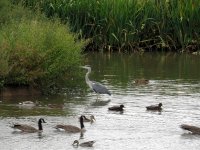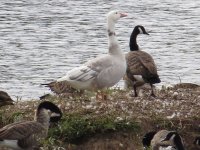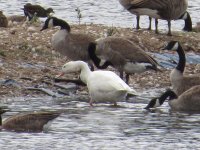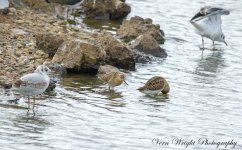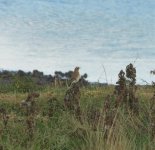-
Welcome to BirdForum, the internet's largest birding community with thousands of members from all over the world. The forums are dedicated to wild birds, birding, binoculars and equipment and all that goes with it.
Please register for an account to take part in the discussions in the forum, post your pictures in the gallery and more.
You are using an out of date browser. It may not display this or other websites correctly.
You should upgrade or use an alternative browser.
You should upgrade or use an alternative browser.
Upton Warren (47 Viewers)
- Thread starter andythomas
- Start date
More options
Who Replied?Where Bird
Well-known member
They don't count do they?......
Seems the Canadas are attracting waifs and strays.The Ross's Goose regularly swims, flies and nestles with them. Not in evidence yesterday afternoon that I could see, but these two were. Your guess is probably better than mine ,but I thought that they were quite striking. Taken from East Hide. When we walked round to West Hide ,it rained so we had a cup of tea in the carand watched everything fly off.
By the time we reached the West Hide the best I could do was a couple or three mallards on the "hitching post" and a couple of the "usual suspects" in the bushes!
Seems the Canadas are attracting waifs and strays.The Ross's Goose regularly swims, flies and nestles with them. Not in evidence yesterday afternoon that I could see, but these two were. Your guess is probably better than mine ,but I thought that they were quite striking. Taken from East Hide. When we walked round to West Hide ,it rained so we had a cup of tea in the carand watched everything fly off.
By the time we reached the West Hide the best I could do was a couple or three mallards on the "hitching post" and a couple of the "usual suspects" in the bushes!
Attachments
Spoonbill Finder
Well-known member
This evening at the Flashes
I spent the last couple of hours of daylight at the Flashes this evening. Casual, sly glances across the Sailing Pool revealed good numbers of Mallard, as well as Pied Wagtails on the jetty and beach areas.
across the Sailing Pool revealed good numbers of Mallard, as well as Pied Wagtails on the jetty and beach areas.
All was then quiet until I approached the Avocet hide, whereupon I saw a bird with a white rump fly up on to the new fencing - the Wheatear seen this morning perhaps? Raising the binoculars to my eyes confirmed the identity of the bird as such; it did indeed look like the bird that Dave (Woodchat) had phototgraphed earlier in the day. The bird flew down, presumably onto the cut grass in front of the hide. However, despite repeated scanning of that area, I failed to relocate it during the rest of my stay.
A flock of 17 Curlews came into roost as soon as I entered the hide. Their number had swelled to 21 not long after. The pair of Ruff were still in evidence, as were 3 each of Common and Green Sandpipers.
I then decided to count the Black-headed Gulls, most of which were on or near the beach in front of the sewage farm. Whilst engaged in this exercise I picked out a juvenile Common Gull standing amongst the 500 plus BHGs. 3 Lesser Black-backed Gulls - 1 adult and 2 juveniles - were also seen during the course of my visit.
The benefit of counting birds - as highlighted in a fairly recent post by John (Upstarts) - came to fruition once again when I picked out a hitherto unseen Dunlin whilst totting up the number of Lapwings present (c50).
Other birds on show included 10 Shoveler, 42 Teal, a few hirundines (mainly swallows) and at least 10 Stock Doves.
This evening's Wheatear took my personal Upton Warren annual tally up to 125 which, with best part of 4 months still to go, is the greatest number I have achieved to date. I will be aiming to hit the 130 mark before the year is out.:t:
I spent the last couple of hours of daylight at the Flashes this evening. Casual, sly glances
All was then quiet until I approached the Avocet hide, whereupon I saw a bird with a white rump fly up on to the new fencing - the Wheatear seen this morning perhaps? Raising the binoculars to my eyes confirmed the identity of the bird as such; it did indeed look like the bird that Dave (Woodchat) had phototgraphed earlier in the day. The bird flew down, presumably onto the cut grass in front of the hide. However, despite repeated scanning of that area, I failed to relocate it during the rest of my stay.
A flock of 17 Curlews came into roost as soon as I entered the hide. Their number had swelled to 21 not long after. The pair of Ruff were still in evidence, as were 3 each of Common and Green Sandpipers.
I then decided to count the Black-headed Gulls, most of which were on or near the beach in front of the sewage farm. Whilst engaged in this exercise I picked out a juvenile Common Gull standing amongst the 500 plus BHGs. 3 Lesser Black-backed Gulls - 1 adult and 2 juveniles - were also seen during the course of my visit.
The benefit of counting birds - as highlighted in a fairly recent post by John (Upstarts) - came to fruition once again when I picked out a hitherto unseen Dunlin whilst totting up the number of Lapwings present (c50).
Other birds on show included 10 Shoveler, 42 Teal, a few hirundines (mainly swallows) and at least 10 Stock Doves.
This evening's Wheatear took my personal Upton Warren annual tally up to 125 which, with best part of 4 months still to go, is the greatest number I have achieved to date. I will be aiming to hit the 130 mark before the year is out.:t:
Phil Andrews
It's only Rock and Roller but I like it

Nice report Andy - yesterdays Common Gull, Spot Fly and Wheater propels the September list to 100
JHWR had been getting 1500 BHGs in the roost last week (but nothing else of interest).
JHWR had been getting 1500 BHGs in the roost last week (but nothing else of interest).
Last edited:
Phil Andrews
It's only Rock and Roller but I like it

JTB at the Flashes: Greenshank dropped in at 0855 and 2 Ruff still
Snow-Bunting
Active member
Long time since I visited UW so must have well and truly lost the plot lol so wonder if someone could just remind me whether the first two photos are a young Greenfinch or Siskin. A couple of additional photos for the record too, Ruff and Wheatear.
Thanks guys.
Thanks guys.
Last edited:
upstarts1979
Well-known member
Update from the Flashes. Greenshank dropped in for about 20 mins before continuing on its way south. 2 juv male ruff. 2 common sand. 1 green sand. 96 lapwing. Curlew. 40 teal. 13 shoveler. 23 moorhen. Plenty of passerines. Whitethroat . Lesser whitethroat. Blackcap. Reed warbler 2. Chiffs 10+. Grey wag. Linnet 30. Small southerly movement of swallows 20+. 50+ house martin.
reedwarbler
Member
Lost Mobile
Lost mobile phone possibly at Moors car park. If found please contact 01527870351.:C
Lost mobile phone possibly at Moors car park. If found please contact 01527870351.:C
Stone Snapper
Warrener till i snuff it
Nice report Andy - yesterdays Common Gull, Spot Fly and Wheater propels the August list to 100
JHWR had been getting 1500 BHGs in the roost last week (but nothing else of interest).
AUGUST hmmmm:-:-O
Abbeybirder
Well-known member
It comes to us all in the end lol
LOL
Originally Posted by Phil Andrews View Post
Nice report Andy - yesterdays Common Gull, Spot Fly and Wheater propels the August list to 100
JHWR had been getting 1500 BHGs in the roost last week (but nothing else of interest).
AUGUST hmmmm:-
LOL
upstarts1979
Well-known member
At flashes earlier. A coupleof meadow pipits ans several swallow (20) on saing pool. Akso 15 sand martin.
Moors
GCG 2 ads and 2 juvs. Little gtrebe 8. Shoveler 22 most from flashes. Teal 18 - 54 in total. Snipe 3. Ruff 2 from flashes.
At North Moors
A bit of "pishing" brought out lesser whitethroat. Blackcap and 5 chiffs.
Moors
GCG 2 ads and 2 juvs. Little gtrebe 8. Shoveler 22 most from flashes. Teal 18 - 54 in total. Snipe 3. Ruff 2 from flashes.
At North Moors
A bit of "pishing" brought out lesser whitethroat. Blackcap and 5 chiffs.
upstarts1979
Well-known member
3 wigeon dropped onto pool island at moors
upstarts1979
Well-known member
Make that 4 wigeon
upstarts1979
Well-known member
Wind strengthening from N . NW.
not a lot to add other than a pair of gadwall. 47 tufted. 5 ads GCG. Coot 120+. Moorhen 21 total of 44 on reserve min..water rail. And Paul A ' s red kite
not a lot to add other than a pair of gadwall. 47 tufted. 5 ads GCG. Coot 120+. Moorhen 21 total of 44 on reserve min..water rail. And Paul A ' s red kite
Phil Andrews
It's only Rock and Roller but I like it

Long time since I visited UW so must have well and truly lost the plot lol so wonder if someone could just remind me whether the first two photos are a young Greenfinch or Siskin. A couple of additional photos for the record too, Ruff and Wheatear.
Thanks guys.
Both Greenfinch SB
Stone Snapper
Warrener till i snuff it
upstarts1979
Well-known member
I spent the last couple of hours of daylight at the Flashes this evening. Casual, sly glancesacross the Sailing Pool revealed good numbers of Mallard, as well as Pied Wagtails on the jetty and beach areas.
All was then quiet until I approached the Avocet hide, whereupon I saw a bird with a white rump fly up on to the new fencing - the Wheatear seen this morning perhaps? Raising the binoculars to my eyes confirmed the identity of the bird as such; it did indeed look like the bird that Dave (Woodchat) had phototgraphed earlier in the day. The bird flew down, presumably onto the cut grass in front of the hide. However, despite repeated scanning of that area, I failed to relocate it during the rest of my stay.
A flock of 17 Curlews came into roost as soon as I entered the hide. Their number had swelled to 21 not long after. The pair of Ruff were still in evidence, as were 3 each of Common and Green Sandpipers.
I then decided to count the Black-headed Gulls, most of which were on or near the beach in front of the sewage farm. Whilst engaged in this exercise I picked out a juvenile Common Gull standing amongst the 500 plus BHGs. 3 Lesser Black-backed Gulls - 1 adult and 2 juveniles - were also seen during the course of my visit.
The benefit of counting birds - as highlighted in a fairly recent post by John (Upstarts) - came to fruition once again when I picked out a hitherto unseen Dunlin whilst totting up the number of Lapwings present (c50).
Other birds on show included 10 Shoveler, 42 Teal, a few hirundines (mainly swallows) and at least 10 Stock Doves.
This evening's Wheatear took my personal Upton Warren annual tally up to 125 which, with best part of 4 months still to go, is the greatest number I have achieved to date. I will be aiming to hit the 130 mark before the year is out.:t:
great account Andy, which part of the fencing was the wheatear on.
Dave's record ...maybe
upstarts1979
Well-known member
This evening at the Flashes
Not much different than this morning.
Athough 3 peregrines are causing havoc amongst the pigeons and corvids. The gulls , waders and duck have learned to sit tight and stay quiet. A juv peregrine is trying to catch anything - without success. The 2 adults are a it more successful.
BHG roost 450 max, snipe, green sand 2, common sand 2, stock dove 61, rook 2. swallow 25 circling late on , not sure if they roosted, I turned my head and they were gone.
Not much different than this morning.
Athough 3 peregrines are causing havoc amongst the pigeons and corvids. The gulls , waders and duck have learned to sit tight and stay quiet. A juv peregrine is trying to catch anything - without success. The 2 adults are a it more successful.
BHG roost 450 max, snipe, green sand 2, common sand 2, stock dove 61, rook 2. swallow 25 circling late on , not sure if they roosted, I turned my head and they were gone.
upstarts1979
Well-known member
Stone Snapper
Warrener till i snuff it
Ifan's pic of wheatear
Great shot Ifan :t:
Similar threads
- Replies
- 1
- Views
- 1K
Users who are viewing this thread
Total: 48 (members: 0, guests: 48)




